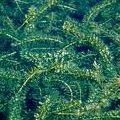- By Hilary Lambert, Steward/Executive Director Cayuga Lake Watershed Network
- Around Town
 Print
Print  Every summer since 2012, June and July were the months when businesses and residences around the south end of Cayuga Lake received notices that chemical treatments were starting soon, to continue the long-term eradication of hydrilla from Cayuga Inlet, Stewart Park near the mouth of Fall Creek, and just offshore in Cayuga Lake's southeastern corner. For six years, interns installed hundreds of stakes topped with yellow notices along the lake's edge and waterways. Not so in 2018!
Every summer since 2012, June and July were the months when businesses and residences around the south end of Cayuga Lake received notices that chemical treatments were starting soon, to continue the long-term eradication of hydrilla from Cayuga Inlet, Stewart Park near the mouth of Fall Creek, and just offshore in Cayuga Lake's southeastern corner. For six years, interns installed hundreds of stakes topped with yellow notices along the lake's edge and waterways. Not so in 2018!The invasive aquatic plant hydrilla (Hydrilla verticillata) was first found by an eagle-eyed intern on the Floating Classroom (a program of Discover Cayuga Lake) in August 2011. A massive coordinated rapid response effort carried out by local and state agencies, researchers and community groups, revealed that 166 acres of Cayuga Inlet – Ithaca's premiere waterway – was infested with hydrilla.
Seven years after that discovery, the news is good: there will be no chemical treatments for hydrilla in Cayuga Inlet or Fall Creek this summer, because no hydrilla has been found in either water body for over a year. Monitoring and testing will continue, to ensure that no hydrilla has returned.
Thanks go to the Hydrilla Task Force team that has overseen a careful, conservative treatment process each year; to the stalwart researchers who have been monitoring the creeks meticulously each year; and to the engaged public and Hydrilla Hunters who have their eyes peeled for its appearance from July to as late as November, when waterways cool down for the winter.
However, there is a recently-discovered patch of hydrilla in shallow waters off Stewart Park; and two plants have been found farther north offshore of the east and west shores, in deeper water. As of mid-July, the Stewart Park plants are beginning to show themselves at the surface. These will be monitored and treated.
This summer, the south end Hydrilla Task Force is working with the US Army Corps of Engineers (USACE) to control these new south-end hydrilla discoveries. In charge of the USACE treatment team is Michael J. Greer, Regional Technical Specialist, U.S. Army Corps of Engineers, Buffalo District.
Teamwork and communication will be key to the two groups' interactions. The Hydrilla Task Force will do the mapping and monitoring. The USACE will treat, using chemicals if the Task Force finds it necessary. The Hydrilla Task Force remains responsible to manage hydrilla by hand removal or with barriers such as benthic mats (thick mats that keep out sunlight). Funding for treatment will be provided by the USACE.
The south-end Hydrilla Task Force is coordinated by Mike Hall and the Tompkins County Soil and Water Conservation District Office. Bob Johnson of Racine-Johnson Aquatic Ecologists provides monitoring services. The Tompkins County Department of Health and Cornell Cooperative Extension are regularly consulted. Hilary Lambert and Jenn Grillo Tufano of the Cayuga Lake Watershed Network coordinate public information and Hydrilla Hunters training and outreach via the Outreach Committee.
v14i28



